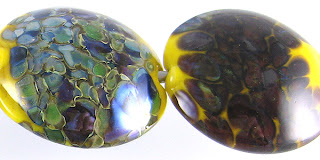Evil Queen is my 100th colour test. That sort of seems like a lot, yet there are more (maybe even a lot more) than 300 104 COE colours out there that I haven't even tried yet. Isn't it fortunate that being tasked with something that even I recognize to be impossible only makes me work harder?
1 - Plain, 2 - Plain (reduced), 3 - w/ Silver Leaf, 4 - w/ Silver Leaf (reduced & encased), 5 - w/ TerraNova2 Frit, 6 - w/ Silver Glass Frit (reduced), 7 - In Silver Glass Frit Stringer (encased), 8 - w/ Tuxedo, 9 - w/ Copper Green, 10 - w/ Opal Yellow, 11 - w/ Ivory, 12 - w/ Peace
CiM Evil Queen is the nicest opaque purple glass I have yet used. As luck would have it, it is also one the most expensive, trailing just behind Effetre EDP in terms of cost.
The consistency of Evil Queen is very soft, smooth and drippy. Some of the other very soft CiM opaques have a noticeable 'stickiness' to them (e.g. Poi, Split Pea, Sherwood) but Evil Queen does not, although that is a pretty meaningless observation because the colours that do have that 'stickiness' are equally pleasant to use. In very thin layers or as hair-thin stringer, Evil Queen is slightly more on the semi-opaque side of opaque, so it's not an ideal colour for surface detail work.
Evil Queen does not devitrify, and pretty much stays where you put it on a bead. It is a little reactive, but in a gentle way, as opposed to the crazy reactivity I experienced with EDP. It does not turn a livery brown with repeated striking the way Effetre Dark Violet does, and isn't particularly streaky like Effetre New Violet or CiM Poi are.
Evil Queen does not change colour when silver leaf is added to the surface, and the silver leaf sort of fans out and balls up on the surface, creating a sort of mist of silver spray. When the silver is subsequently reduced and encased, it gets some blue highlights and forms a solid, matte armour-like coating over the core of Evil Queen. I think the yellowing that we can see in the bead on the right is due to a reaction between the Clear and the silver, and is not attributable to the Evil Queen.
Silver Glass on Evil Queen isn't very exciting. My TerraNova2 frit stubbornly refused to strike, although the light purple halos that sprung up around it are very neat. The reducing silver glass frit on top of it just looks kind of mottled and sad, but it is kind've intriguing how reducing the silver glass made the Evil Queeen underneath take on a shiny, purple iridescence. When I used Evil Queen with silver glass frit in frit stringer, wrapped that around a core of Evil Queen and then encased it, I got a little bit of interesting streakiness, but Evil Queen is just not reactive enough to really succeed with this technique.
Evil Queen and Tuxedo are mutually reactive. When Tuxedo is used on top of Evil Queen, the Evil Queen rises up around the Tuxedo dots and stringer lines and forms a lighter purple outline around its edges. When Evil Queen is used on top of Tuxedo, it separates, developing a dark, translucent purple line in the middle of stringer lines, and the edges of the stringer lines and dots look a little hazy on the left side of this bead.
The combination of Evil Queen and Copper Green doesn't really result in a lot of reactivity, but a couple of things sort of spark my interest here. First, the Copper Green develops a bit of a sheen. On the left side of the bead where the Evil Queen is over Copper Green, the Copper Green looks sort of vibrantly turquoise, but has also sheened up, taking on a dreamy, mottled appearance. On the right side of the bead where Coper Green is over Evil Queen, the Copper Green does not have that vivid turquoise colour, but does seem to have spread a little and is definitely somewhat shiny.
On the left side of the bead, you can see how the dots and stringer lines of Evil Queen have separated gently, and a darker line of purple runs through the stringer lines. The edges of the Evil Queen dots and stringer lines seem a little blueish and indistinct.
Opal Yellow and Evil Queen are both soft, spready colours, so it was not very surprising that I experienced some spreading of the dots and stringer lines on both sides of this bead. On the right side, where Opal Yellow is over Evil Queen, the edges of the Opal Yellow are sort of indistinct and have a somewhat violet hue to them. On the left side, where Evil Queen is over Opal Yellow, the Evil Queen has also spread a little, and has also separated into two different shades of purple, a thickish, lighter line forming around the edges of the dots and stringerwork. Neat.
Ivory spreads out a little on top of Evil Queen, and my Ivory stringer lines and dots also have a curdled, mottled appearance. On the left side of the bead, the Evil Queen dots all have a lighter purple outline and faintly darker centre. Their edges are also a little cloudy and indistinct.
Over Peace, Evil Queen seems more of a semi-opque than an Opaque. Peace spreads on top of it, and you can see in the centre of the bead how the Evil Queen has bled into the Peace turning it a purplish blue colour.
I didn't make any real beads with Evil Queen, but I am sure that I will revisit this colour. When I do, I will come back and update this post with some pictures.


















































